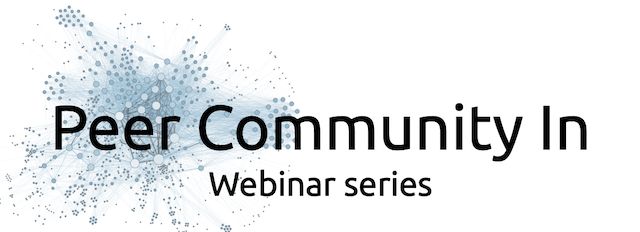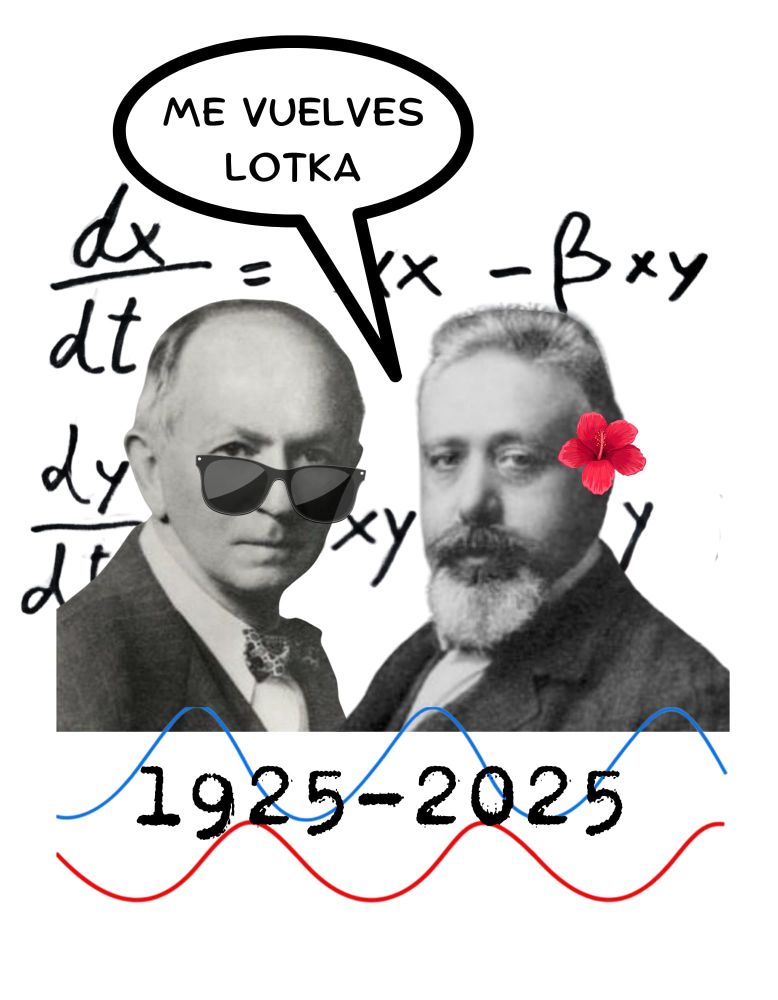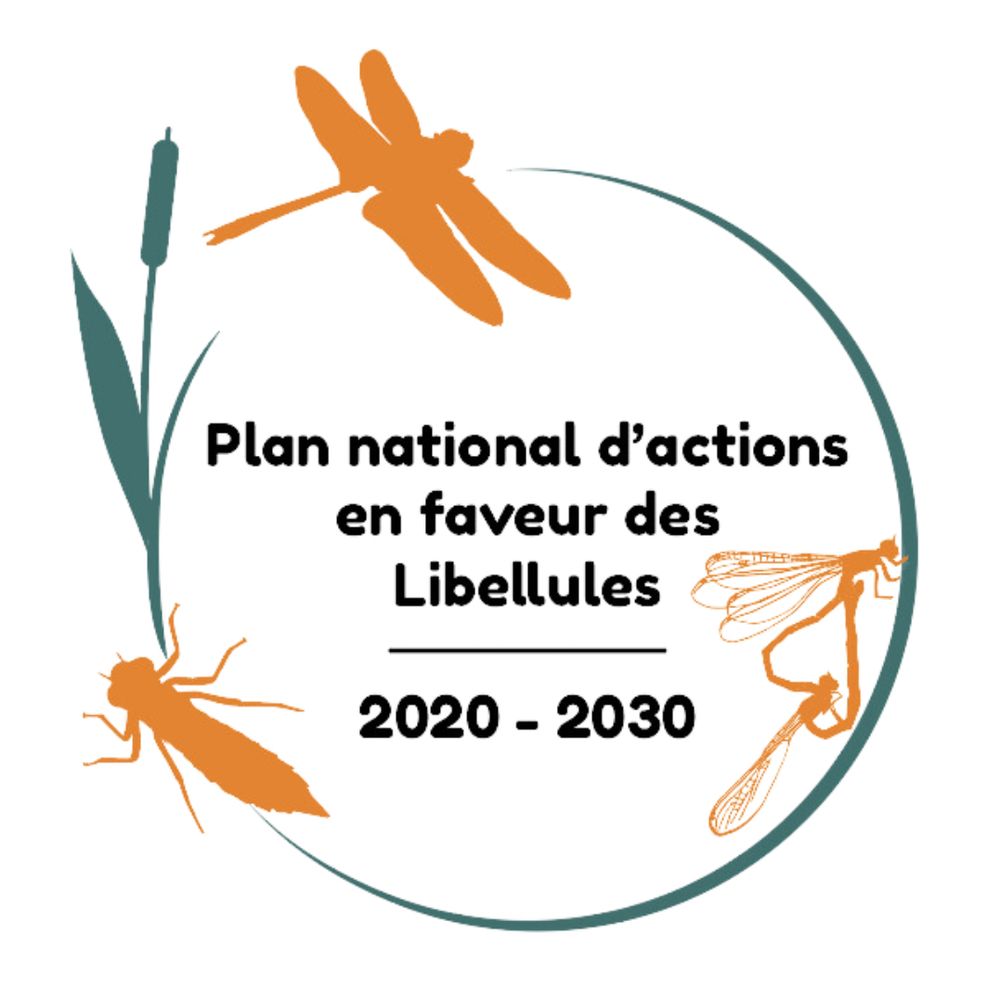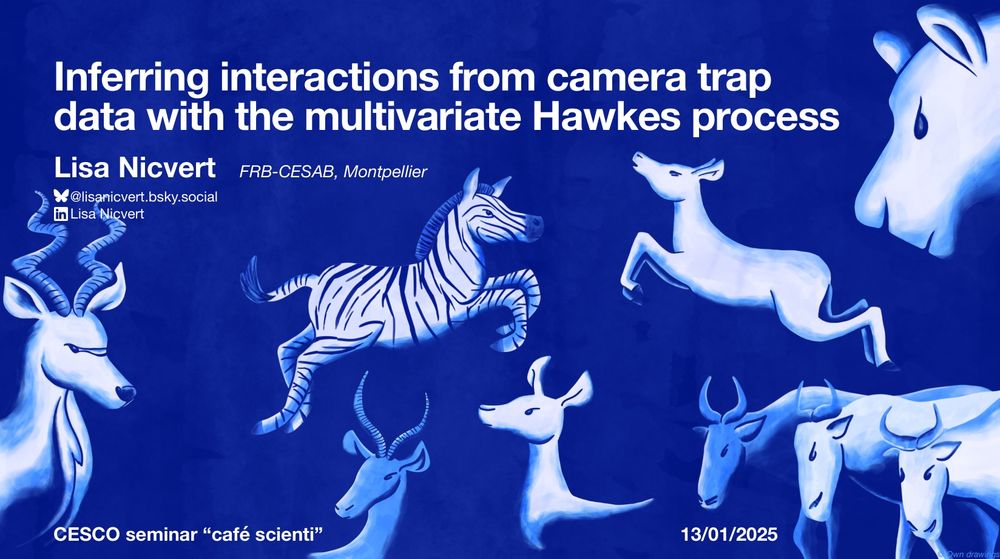Very happy to share our new paper published in Current Biology !
We show that the “big bad wolf” actually fears humans for good reason.
It’s the first-ever playback experiment on wild wolves in Europe 🇵🇱🌲.
03.10.2025 13:01 — 👍 17 🔁 4 💬 0 📌 0

Our International Postdoc Forum is a virtual seminar series for early career researchers to share their work w/commentary by MCPS community members. Excited to welcome @rosetrappes.bsky.social (University of Bergen, Norway) at 1215 CT Wed 24 Sept. Sign up for Zoom link. buff.ly/MSAXLgY
10.09.2025 15:15 — 👍 16 🔁 9 💬 0 📌 1

brown and blue graphic with white text and logos overlaying. Text reads why countries need the global biodiversity information facility: lessons from belgium
🌍 Why countries need GBIF: lessons from Belgium
A recently published policy brief provides details how Belgium has leveraged GBIF to support sustainable development, conservation and innovation for effective #biodiversity governance.
🔗 doi.org/10.5281/zeno...
01.09.2025 11:20 — 👍 12 🔁 12 💬 0 📌 3

Title and author list for the synthesis paper titled "Understanding and Predicting Population Response to Anthropogenic Disturbance: Current Approaches and Novel Opportunities" published in Ecology Letters.
The latest paper from the DISCAR synthesis group is out at Ecology Letters! We discuss the key approaches to predicting human impacts on wildlife populations, highlighting avenues for incorporating indirect effects, such as energetic modelling. doi.org/10.1111/ele....
23.08.2025 10:40 — 👍 47 🔁 26 💬 2 📌 2
It was a pleasure to attend and speak at this great conference! @ecobhvr2025.bsky.social
14.08.2025 15:32 — 👍 3 🔁 0 💬 0 📌 0

Disability in ecology and evolution
In this TrendsTalk series 'Disability in ecology and evolution' in Trends in Ecology
and Evolution, we will be hearing from people about their experiences being disabled
in ecology and evolution. We a...
Huge thank you @aeastephens.bsky.social for initiating the TrendsTalk series 'Disability in ecology and evolution' in T.R.E.E. providing visibility for disabled researchers in #Ecology & #Evolution to make our field more #inclusive www.cell.com/trends/ecolo...
26.07.2025 07:58 — 👍 37 🔁 18 💬 0 📌 1
Also, you can read this post which describes our findings! bsky.app/profile/lisa...
18.07.2025 06:53 — 👍 0 🔁 0 💬 0 📌 0
Our article is now out in Peer Community Journal! If you are interested in network ecology, trait matching or multivariate methods, read it here (in open access) ⬇️
🌐
18.07.2025 06:50 — 👍 7 🔁 0 💬 1 📌 0
So nice to talk about science together!
16.07.2025 13:43 — 👍 0 🔁 0 💬 0 📌 0
Trait matching without traits: using correspondence analysis to investigate the latent structure of interaction networks
Species interactions in ecological communities are often represented as networks, the structure of which is thought to be linked to species' interaction niches (or Eltonian niches). Interaction niches are intimately related to the notion of trait matching, which posits that a species interacts preferentially with partners whose traits are complementary to their own. Multivariate methods are commonly used to quantify species environmental niches (or Grinnellian niches). More recently, some of these methods have also been used to study the interaction niche, but they consider only the niche optimum and require trait data. In this article, we use the correspondence analysis (CA) framework to study interaction networks and investigate trait matching without requiring trait data, using the notion of latent traits. We use reciprocal scaling, a method related to CA, to estimate niche optima and breadths, defined respectively as the mean and standard deviation of the latent traits of species' interacting partners. We present the method, test its performance using a simulation model we designed, and analyze a real frugivory network between birds and plants. The simulation study shows that the method is able to recover niche breadths and optima for data generated with parameters typical of ecological networks. The birds-plants network analysis shows strong relationships between species latent traits and niche breadths: a posteriori correlation with measured traits suggests that birds and plants of intermediate size tend to have the broadest niches. Additionally, birds preferentially foraging in the understory have broader niches than birds preferentially foraging in the canopy. CA and reciprocal scaling are described as fruitful exploratory methods to characterize species interaction profiles, provide an ecologically meaningful graphical representation of interaction niches, and explore the effect of latent traits on network structure. ### Competing Interest Statement The authors have declared no competing interest. Agence Nationale de la Recherche, ANR-18-CE02-0010 (project EcoNet)
Many thanks to PCI (@peercommunityin.bsky.social) Ecology for a smooth revision process, and to the reviewers @ibartomeus.bsky.social and Pedro Henrique Pereira Braga. Read the full article here: doi.org/10.1101/2024... (to be published in Peer Community Journal soon) (6/6)
09.07.2025 07:57 — 👍 4 🔁 0 💬 0 📌 0
Of course, a latent approach means that the results can sometimes be difficult to interpret, and conflate different characteristics of species which are not generally considered as "traits". But I still think CA and reciprocal scaling are interesting approaches to analyze interaction networks. (5/6)
09.07.2025 07:57 — 👍 2 🔁 0 💬 1 📌 0

Figure 7 from the article: Correlation circle measured a posteriori between species measured and latent traits. Bird traits are shown in solid red lines and plant traits in dashed blue lines. Axis 1 shows a size effect while axis 2 is defined by the matching between plant height and Kipp’s index.
We also find out that the axes are fairly related to some species' traits thought to be related to trait matching: beak width and fruit diameter, body mass and crop mass, and Kipp's index and plant height. This suggests that this latent trait approach captures known trait matching patterns! (4/6)
09.07.2025 07:57 — 👍 1 🔁 0 💬 1 📌 0

Figure 5 from the article. Reciprocal scaling of the birds-plants interaction network. Points correspond to the interaction scores h_k(i, j) in the first 2 dimensions, grouped by bird (a) or plant species (b). Species label are placed at the reciprocal scaling mean, and ellipses correspond to the bivariate normal distribution with variances and covariances given by reciprocal scaling (with a scaling factor of 1.5, i.e. the ellipse axes lengths are equal to 1.5*sqrt(λk) on axis k, corresponding to around 67% of the points contained in the ellipse). Ellipses are colored according to the rank of their centroid on the first axis. The correspondence between species’ codes and names is given in Appendix D.
We use a simulation approach to test the method, and illustrate it on a bird-plant frugivory network. Below are species' niches in the multivariate space for birds and plant species interacting in this network. (3/6)
09.07.2025 07:57 — 👍 3 🔁 0 💬 1 📌 0

Figure 1 from our article: Visualization of the interaction niche in a 2-dimensional space. The niche is depicted by an ellipse whose center represents niche optima and semi-axes represent niche breadths. The angle of the ellipse represents the covariance between niche axes. Points represent interaction scores.
In this article, we relate the interaction niche to trait matching. For that, we use reciprocal scaling, a method related to correspondence analysis, which allows to represent species' niches in the multivariate space and where the multivariate axes can be interpreted as latent traits. (2/6)
09.07.2025 07:57 — 👍 1 🔁 0 💬 1 📌 0
Moving functional network ecology forward (without traits)
Is it possible to infer trait matching in ecological networks, even when no trait information is available? In our new article, just recommended by Timothée Poisot (@ctrlalttim.com) for PCI Ecology, we suggest that it is possible! Read the recommendation here: doi.org/10.24072/pci... 🌐 (1/6)
09.07.2025 07:57 — 👍 10 🔁 0 💬 2 📌 1

Cover of my presentation of the DRAGON project

Me in the field!
This weekend, I took part in the odonatological meeting of the Opie! I presented the DRAGON project I'm working on, and learned how to identify dragonflies in the field. It was an amazing weekend of sharing scientific and naturalist knowledge, while meeting great and passionate people!
08.07.2025 07:54 — 👍 7 🔁 1 💬 0 📌 0

Our Dragon consortium brainstorming at Cesab
Last week was our Dragon project workshop at Cesab! This was a great week of collaborative work to discuss dragonfiles, occupancy models and a lot more! Time to get those models running now 👩💻
14.04.2025 07:42 — 👍 5 🔁 0 💬 0 📌 0

🥁 Reminder: Our next PCI webinar is on March 20, 2025, at 4 PM CET. Sabina Leonelli from the Technical University of Munich will discuss "When Open Publishing Is Not Fair." For more details and registration, visit: buff.ly/49QXV0R
12.03.2025 09:24 — 👍 4 🔁 4 💬 0 📌 0
We #StandUpForScience
07.03.2025 09:44 — 👍 2 🔁 0 💬 0 📌 0

100 years with the Lotka-Volterra equation... let's celebrate!
29.01.2025 07:21 — 👍 66 🔁 22 💬 0 📌 2
During this meeting, I presented the Dragon project (for which I am a postdoc) and gathered the input and ideas from people in the room. Very helpful before starting data analysis 👩💻
16.01.2025 19:39 — 👍 0 🔁 0 💬 0 📌 0

Logo of the National Action Plan
Today I was invited to a meeting gathering actors from the French National Action Plan for Dragonflies, held in Paris. I learned a great deal about odonates conservation in France at the national and regional scales. I also had the chance to meet a lot of knowledgeable and very nice people!
16.01.2025 19:39 — 👍 1 🔁 0 💬 1 📌 0
Congratulations for this great defense 🥳
11.12.2024 10:05 — 👍 0 🔁 0 💬 0 📌 0
Every year around now, I start to see grad students on social media bemoan that they’re going home for the holidays to a family that doesn’t understand their research, or what they do in general, and it breaks my heart. 🧵 🧪 #SciComm
08.12.2024 16:22 — 👍 689 🔁 185 💬 33 📌 72
Postdoctoral researcher | large carnivore ecology 🐺🦁 | Predator prey interactions 🦌🦓| Human wildlife conflict 🐑 🏔️
Updates from the United Kingdom Butterfly Monitoring Scheme (UKBMS).
To find out more about the scheme visit - https://ukbms.org/
We are working towards a world inspired by ecology in which nature and people thrive.
We are the British Ecological Society Macroecology & Macroevolution Special Interest Group. We run the annual #BESMacro conference and will gladly repost papers and opportunities of interest to our members!
Mexican Historian & Philosopher of Biology • Postdoctoral Fellow at @theramseylab.bsky.social (@clpskuleuven.bsky.social) • Book Reviews Editor for @jgps.bsky.social • #PhilSci #HistSci #philsky • Escribo y edito • https://www.alejandrofabregastejeda.com
Discover new research from across the sciences and highlights from the world's longest-running journal archive. Part of @royalsociety.org royalsociety.org/journals
The official account for UK wildlife charity Butterfly Conservation. Saving butterflies, moths and our environment. 🦋
https://butterfly-conservation.org/
Cover photo 📷: Small Copper - Paul Henson
A free, collaborative, multilingual internet encyclopedia.
wikipedia.org
« Imaginez un monde dans lequel chaque personne sur la planète aurait accès à l'ensemble des connaissances humaines. »
Compte animé par des contributeurs et contributrices bénévoles de la version francophone de Wikipédia.
Postdoc in @econovoau.bsky.social - diversity dynamics in novel ecosystems. Palaeo/macro-ecology.
Also chatting craft beer, tabletop gaming, and open/ethical science.
Views mine. He/him. 🐚🐟🌍
Evolutionary biology, genetics, conservation & beyond
@szndohrn.bsky.social 🧜♀️ 🌊 @cemeb.bsky.social
Bio-diverse & inclusive community 🌈
raffinifrancescalab.weebly.com
littorina.at.biopolis.pt
gu.se/en/cemeb-marine-evolutionary-biology
Professor in Behavioural ecology, particularly interested in flight & animal movement
Researcher in biodiversity conservation (macroecological scale | protected areas | bird migration) • Apprentice in historical ecology (impacts of ancient whaling) • Senior Researcher @CNRS • Home lab: CEFE • Home uni: University of Montpellier, France.
Managing editor for @peercommunityin.bsky.social & behavioral ecologist in my spare time (among-individual variation, urban adaptation & intraspecific competition). Other interests: food, cats, photography & a liveable planet for all. Views my own.
Postdoctoral researcher at CASUS, Germany, studying animal movement and road interactions. Interested in #MovementEcology, #RoadEcology, and #BatConservation.
Developer of the R Shiny application 'movedesign':
https://github.com/ecoisilva/movedesign.
Eco-evolutionary dynamics explorer | Bridging Ecology, Evolution and Biodiversity Conservation | Associate Editor Functional Ecology | Eternal Judo /BJJ grasshopper.
Website: https://bastazini.github.io
Blog: https://geekcologist.wordpress.com
- Lecturer at the University of East Anglia.
- Interested in ageing and parental effects.
- Fond of burying beetles.
- R and Shiny enthusiast.
- Data editor at Ecology Letters.
- President of SORTEE.
- Website: https://eivimeycook.github.io
Postdoc at Université de Lausanne (Switzerland) with Nicolas Salamin.
Population genetics and phylogenetics, confronting or integrating them.
https://thibaultlatrille.github.io/
PhD Candidate 📚 Princeton University 🐅 Ecology & Evolutionary Biology 🦋 Patterns & processes of macro scale biodiversity loss 🪺🪹
Evolutionary Ecologist #CNRS @cefemontpellier | quantitative genetics | wild birds response to climate change & urbanization | #TeamHB3 #womeninSTEM















